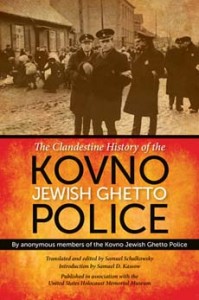A memorial plaque commemorating Yuda Zupavich, Kaunas ghetto Jewish police chief and underground resistance leader, is to be unveiled at E. Ožeškienės street No. 21 in Kaunas at 1:00 P.M. on July 13. The initiative to commemorate this person came from the Lithuanian Jewish Community. LJC chair Faina Kukliansky approached the Kaunas municipality asking them to commemorate this noble citizen of Kaunas who rescued people from the Kaunas ghetto in World War II and who himself was murdered at the Ninth Fort in Kaunas. Zupavich, a lieutenant in the Lithuanian military reserves, was a leader of the Kaunas ghetto Jewish police force and of the underground ghetto resistance, and was brutally tortured to death at the Ninth Fort in Kaunas in 1944.
Yuda Zupavich’s widow Dita Zupovich-Sperling is planning to travel from Israel to attend the ceremony. LJC chair Faina Kukliansky, Kaunas city leaders and LJC members are also planning to attend.
On September 22 last year a series of frescoes commemorating earlier residents was unveiled at E. Ožeškienės street No. 21 in Kaunas, including Kaunas ghetto heroes and victims Yuda Zupavich and Ilka Grinberg. The frescoes were the work of the artist Vytenis Jakas who now lives at that address.
Dita Zupovic-Sperling has sent a moving message from Tel Aviv:
“I am in our courtyard again. It is silent. Many, many years have passed. I see myself, a young gymnasium student always in a hurry, full of energy and vigor. And I see us later with Yuda, happy, moving towards a new life. One sunny Sunday morning it all disappeared as if it had been nothing but a beautiful dream…
“The ghetto now. Here I know a different Yuda, whom they have proposed as a former lieutenant in the Lithuanian military reserves to organize the Jewish ghetto police as well as its underground activities. I now know a partisan who was almost certain he would pay for that with his life. This was an inner struggle: on the one side people had to be handed over to the Germans for hard labor, on the other side there was the effort to help one’s own people. I see that this was leading to oblivion and death, but I decided I had no right to talk him out of it, let him operate according to his own conscience.
“The Kaunas ghetto Jewish police were very active participants in the underground. Only with help from the Jewish police was it possible to bring children out from the ghetto, to bring weapons in and out, to bring in food secretly in carts. There was a bunker in the ghetto where they taught how to shoot, the ghetto was secretly photographed, documents were collected and the names and actions of the Nazis were being recorded. For three years the Jewish ghetto police secretly kept a daily record of events. This chronicle was hidden in different locations. Yuda always used to emphasize to me that after the war the world must learn the whole truth. He explained where it was all buried and what to do when he was gone.
“Yuda was brutally tortured, but he kept quiet. As they were taking him to be shot, he sang his favorite song, in Hebrew: ‘This song has bewitched me and there will never be another!'”
“Clandestine History of the Kovno Jewish Ghetto Police” is a book written in Yiddish by Yuda Zupavich and other Jewish ghetto police. For many years the manuscript slumbered in a box buried deep under the Slobodka ghetto, but was finally discovered and removed to the basement of the KGB building. After the restoration of Lithuanian independence a microfilm of the manuscript was sent to the Holocaust Museum in Washington, D. C., and the Beit Hatefusot, or Museum of the Jewish People, in Tel Aviv. It was translated to English and recently published in the USA.
“Clandestine History of the Kovno Jewish Ghetto Police” won the bronze prize in the 2014 Indiefab independently published books awards for best book of the year and took silver in 2015 in the category of world history in the independent book publisher awards.


